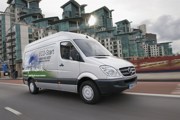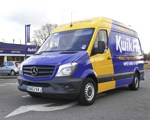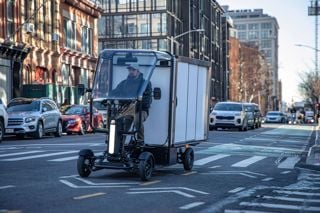Specifying the right livery for a van fleet can have far-reaching benefits for a company.
A vehicle with an eye-catching design with clear contact details can improve a firm’s image, raise awareness of it and help win new business.
Applying a vinyl wrap can also increase the value of a vehicle at defleet time, as it can protect the paintwork underneath, giving the body an ‘as new’ appearance when it is removed.
Here we look at six areas to consider to get the most out of van livery.
Selecting a supplier
Choosing the correct supplier is vital to ensure vans are fitted with the right livery – both from a design and quality point of view.
“If you are unsure which livery company to use, ask for a recommendation – is there a supplier which has van graphics you like the look of?” says Rebecca Dack, of Signs Express. “Is the supplier a member of a recognised trade association such as the British Signs and Graphics Association? This industry body provides customers with certain reassurances on quality standards.
“Also find out if the vehicle graphics will be fitted indoors. For graphics to last a long while, they need to be applied in the right temperature. It’s likely that graphics applied outside will have problems adhering to the vehicle.
“This won’t happen immediately but within a couple of months, by which time the supplier may not be willing to help.”
Signs Express has its own climate-controlled application bay at each of its production centres to ensure consistency.
Don’t be afraid to switch suppliers.
Autoglass recently moved to Sign Language after a 20-year association with its previous livery company.
“I wanted to look at the market as we had used our previous supplier for many years,” says Ged Raymond, fleet manager at Belron, Autoglass’s parent company.
“Sign Language was a company that had made contact with us in the past, so I went to tender and it won the contract.”
Raymond says switching suppliers brought a cost saving. “More importantly it introduced us to a better product which applies and removes easier than the material we were using,” he adds.
Design
One company which is reaping the rewards of getting its vehicle livery right is Kwik Fit, which last year began to give its mobile tyre-fitting fleet a new look.
“Our research showed we could generate improved visibility and therefore potentially extra business by introducing a more striking livery on the mobile fleet than our previous livery displayed on a white van,” says Simon Lucas, the company’s fleet operations director. “Utilising Kwik Fit’s corporate blue and yellow colours does, we believe, provide an enhanced mobile billboard to raise greater awareness of our mobile tyre-fitting service.”
Careful consideration should be taken when settling on a design. “Customers should ask themselves what the one thing they want to get across is,” says Dack.
“Some designs try to include too much information which loses the focus of the vehicle graphics.”
Any text should be clear and easy to read even when the van is on the move, while the rear of the vehicle is an obvious place to include contact details.
Most livery companies will design a wrap in one of two ways. The first is to take an image or logo and apply it to a computer template of the van it will be applied to.
This allows the wrapper to make sure the design fits properly and shows your logo in the way you intended.
The other way is to ask the wrapping company to come up with a bespoke design. It will have templates and designs to work from or it can design something from scratch.
Bespoke designs tend to attract an extra cost (see minimising costs panel).
Minimising costs
The typical cost for a small van in a simple complete vehicle wrap is around £700, while a large van with a complicated wrap could cost £1,500. Much of this cost is due to labour as it could take 15 hours to apply.
Bespoke designs can add several hundred pounds to a wrap, depending on how complicated it is.
“A great compromise for customers who want to have high-impact vehicle graphics but want to keep costs
minimised is to get a part wrap,” says Dack.
“This involves the covering of part of the van, usually the rear quarter, and integrating this into the design.
“It means you can have an excellent contrast between the paint colour and the vinyl, plus there is a good size of coverage to get your message across.”
Part wraps of a medium van cost typically £550-£950.
























Login to comment
Comments
No comments have been made yet.